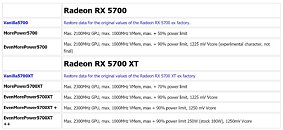Monday, July 15th 2019

RX 5700 XT Navi Crosses 2.2 GHz Thanks to Custom SoftPowerPlay Table Registry-Mod
Igor Wallossek of Igor'sLAB Germany postulated a method by which an AMD Radeon RX 5700 XT "Navi" graphics card can be made to run at clock-speeds of over 2.20 GHz (engine clock), thanks to custom SoftPowerPlay Tables (SPPTs) deployed by modifications to the Windows Registry. The AMD Radeon driver is designed such that it reads PowerPlay tables from the video-BIOS of an RX 5700-series graphics card the first time it's detected, and writes it onto the Windows Registry for quick-reference. This is called a SoftPowerPlay Table or SPPT. It's the modification of SPPTs that allows you to manipulate the power limits of RX 5700-series graphics cards, and achieve higher engine clocks than the 2150 MHz engine-clock limit of the RX 5700 XT, which is set at just 1850 MHz for the RX 5700.
Wallossek's mod involves preparing your Windows Registry with a driver cleaner such as DDU, downloading and applying Registry files for various new power-limit targets you want. The table below details the various power-limit and clock headroom on offer from each kind of registry file. There's also a registry file that cleans up your Windows Registry of any SPPTs, if you decide to roll-back your mod. You can inspect a registry file by opening it in a plaintext viewer such as Notepad. Find links to the SPPT mods, and the Registry Cleanup in the source link below. You can also watch a video presentation by Wallossek in German language here. You make any changes to your machine at your own risk, be sure to have proper custom cooling for your graphics card.
Source:
Igor'sLAB
Wallossek's mod involves preparing your Windows Registry with a driver cleaner such as DDU, downloading and applying Registry files for various new power-limit targets you want. The table below details the various power-limit and clock headroom on offer from each kind of registry file. There's also a registry file that cleans up your Windows Registry of any SPPTs, if you decide to roll-back your mod. You can inspect a registry file by opening it in a plaintext viewer such as Notepad. Find links to the SPPT mods, and the Registry Cleanup in the source link below. You can also watch a video presentation by Wallossek in German language here. You make any changes to your machine at your own risk, be sure to have proper custom cooling for your graphics card.

44 Comments on RX 5700 XT Navi Crosses 2.2 GHz Thanks to Custom SoftPowerPlay Table Registry-Mod
Realistically, though, how much more can the RX5700 XT be pushed? It feels like there are some gains to be had, but when W1zzard tested it, it was pretty much broken...
I would like to see some benchmarks with this.
But, yeah, iirc, OCed you could nearly double the performance of xfire 6900s. I had flashed/xfire 6950s and got a 7950...then another. Multigpu died shortly after. And people want to know why I call devs lazy in every thread.
The internet: 5700 XT runs at 2.2GHz! Cool runnings!
The internet: Cool runnings!
Weak attempt at trolling. Try again next time.
I can imagine AMD re-launching Navi with boost frecuencies just like it did with Polaris.
So RX 6700XT (5700 XT + 200Mhz) in a lower nm fab at lower prices of course, and this may be side by side
competing with GTX cards from next year and Navi+Raytracing capabilities that will compete with RTX3000 from Nvidia.
As for launching boosted SKUs here, I kind of doubt that. They have plenty of room for bigger silicon to deliver more performance (remember, this die is 100mm2 smaller than the 7970), and these cards are already a bit high on power for the price bracket.
I wouldn't be surprised if we saw 60/64 and 80-ish CU Navi dice in the future (the latter likely with HBM2). More CUs would allow for more performance while lowering clocks to keep power draw in check (an 80CU Navi GPU at 1500MHz might still draw >300W, but it would perform like crazy), and while the biggest would be a large die (at least 500mm2) it would be nothing compared to Nvidia's latest monster dice.
Tl;dr: there's no reason to expect AMD to go crazy pushing clocks on these cards. That they can scale higher doesn't mean they should (from the factory) or that that makes sense in the real world. AMD needs higher end silicon regardless, and it's obviously coming - this is just the first design, after all.
Guess people extrapolate from the success of the HD 6950 and HD 7970.
Bought a Sapphire HD 6950 2GB with the Reference blower for ~ 220€ in 2011 myself, slapped a Peter on it and copper cooling blocks on Vram and VRM as well as to flash it with a modified 6970 bios (Shaders 1408 -> 1536 / 880MHz core / 1250 MHz memory), which all in all was costing less than a Reference HD 6970!
Started OC'ing and ended up with 1 GHz core and 1500 MHz on the memory @ ~ 1.265 V.
I was aware it might only work 1-2 years like that, but with the price/perf ratio I was fine with it. In the end, the card worked without issues until late 2015.
It might have worked longer without the flash and OC, but in reality, if it manages 2-4 years it gets replaced by a newer card anyway in most cases, which means the added degradation doesn't really factor into the use case.
Igor is right in stating, that OC'ing anything reduces its lifespan, but nobody knows by how much. In the video, he states, that 1.25 V might not be for 24/7, but two sentences later he says 1.2 V might very well be. Haven't OC'ed a 5700 XT so I don't know how far you get with 1.2 V, but I guess ~2Ghz 24/7 would still be plenty.